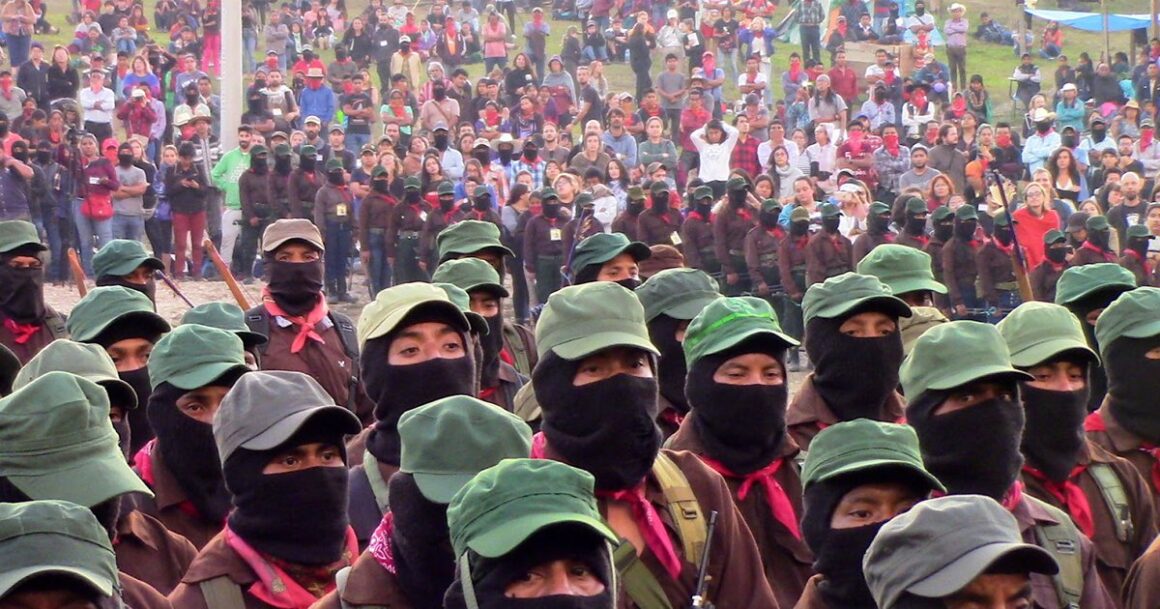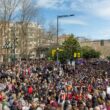By Alternativa Socialista Mexico (our sister organisation in Mexico)
Thirty years ago, on January 1, 1994, the Zapatista Army of National Liberation (EZLN) rose up in arms in the state of Chiapas, shouting “Ya basta!” (Enough is enough). In this way, hundreds of Mayan, Tzotzil and Tzeltal indigenous people denounced poverty, hunger and misery in one of the poorest states in the country. After the fall of the Berlin Wall, the failure of Stalinism, the dissolution of the socialist bloc and the retreat of the Central American guerrillas, in the southeast of Mexico, thousands of armed indigenous people took the world by surprise, becoming a reference for millions of young people, women and workers who did not capitulate to the so-called “end of history” or renounce the struggle for the radical transformation of society.
Chiapas: 500 years of continuing poverty, misery and violence
“We are a product of 500 years of struggle: first against slavery, then during the War of Independence against Spain led by insurgents, then to avoid being absorbed by North American imperialism, then to promulgate our constitution and expel the French empire from our soil, and later the dictatorship of Porfirio Diaz denied us the just application of the Reform laws and the people rebelled and leaders like Villa and Zapata emerged, poor men just like us. We have been denied the most elemental preparation so they can use us as cannon fodder and pillage the wealth of our country. They don’t care that we have nothing, absolutely nothing, not even a roof over our heads, no land, no work, no health care, no food nor education. Nor are we able to freely and democratically elect our political representatives, nor is there independence from foreigners, nor is there peace nor justice for ourselves and our children.”— First Declaration of the Lacandon jungle
Thus begins the Declaration of the Lacandon Jungle, with which the EZLN announced the root causes of its uprising, calling on the people of Mexico to join against the “clique of traitors that represent the most conservative and sell-out groups.” The call, and the characterization of the situation in the Southeast was not rhetorical, since the founding of independent Mexico the south of the country had experienced conditions of backwardness and social misery. At the end of the 1990’s alone, the states of Chiapas, Guerrero and Oaxaca had a total of 4 million people suffering from hunger and starvation. During this period, the region had a population of 53.3 million people living in poverty and 11.5 million in extreme poverty, according to CONEVAL data. The infant mortality rate was and continues to be one of the highest in the country, on par with the number of deaths due to violence and organized crime. In 1993, Chiapas had more than 75% of its population living in poverty. The most vulnerable were, and continue to be, the indigenous and peasant communities of the region. These communities were historically exploited and oppressed since the time of the conquest and independent Mexico.
In addition to the abandonment of indigenous communities, the Mexican state also discriminated against them on ethnic and linguistic grounds. Tsotsil, Chol, Mayan and other languages of the region were systematically marginalized as languages, both by the campaigns of castellanization and by the use of Spanish as the exclusive language of public, educational and labor life in the State. Chiapas, where 30% of the population is indigenous, and where the majority of the population lives in the highlands and the jungle, suffers the highest rates of ethnic hate crimes. For centuries, the indigenous communities, cut off from the urban centers, found themselves in conditions of misery due to the lack of resources and basic state services, such as health, water, education, housing and food.
While conditions of misery worsened, in 1992, the government of Carlos Salinas de Gortari signed the North American Free Trade Agreement (NAFTA) between Mexico, the United States and Canada. The treaty, whose objective was to liberalize trade between these countries, opened the door to increased inequality in the region, while encouraging the theft of land and exploitation of natural resources by foreign companies. Land dispossession in Chiapas increased in the last decades, towards the end of the 1990s, with the support of the Mexican army and paramilitary groups headed by the military governor Absalón Castellanos. This governor followed a long PRI tradition of government and military presence in the region.
The origins of the EZLN
In this context, the EZLN developed at the end of the 1980s. It was preceded by the Fuerzas de Liberación Nacional (National Liberation Forces) — a self-proclaimed Marxist organization founded in 1969 inspired by the Cuban revolution and striving to organize a guerrilla movement for the construction of socialism in Mexico. However, in the 1970s, it suffered an abrupt persecution and total liquidation of its structure by the repression of the Mexican State and its intelligence agencies.
In 1983 it succeeded in reorganizing its activist base among a peasant and indigenous mass fed up with its situation and settled in the rural areas of Chiapas to continue its activities. The surviving FLN leadership decided to reorient the struggle for socialism and adapt its program and structure to the new conditions presented by the defeat of the Stalinist bloc and the retreat of Marxist forces at the international level. Thus, the organization evolved under the name of the Zapatista Army of National Liberation. Other ideas impacted the reorientation of the EZLN’s program, such as Liberation Theology, a political-religious movement in Central America, and the social doctrine of the Catholic Church with the Bishop of San Cristobal de las Casas, Samuel Ruiz Garcia.
In 1993, the Revolutionary Indigenous Clandestine Committee was formed as a leadership body, made up of mestizo and indigenous peasants. For decades they recruited new combatants, formed zones administered and supplied by the insurgent leadership and organized the indigenous peoples politically under the command of a military structure.
The day of the uprising
Waiting for the moment of insurrection, the EZLN revolted on January 1, 1994, the day the North American Free Trade Agreement (NAFTA) came into effect, demanding the vindication of property rights over the lands taken from the indigenous communities, a better distribution of wealth and the participation of the different ethnic groups in the organization of the state of Chiapas as well as in the rest of the country. Places such as San Cristóbal de las Casas, Altamirano, Las Margaritas and Ocosingo were the center of the insurrection. The virtue of the Zapatistas lies in being a popular insurrection that proposed an anti-capitalist alternative, at a time when Marxism and socialism had lost their strength among the working class due to the errors and horrors of Stalinism.
In those early days, the “Declaration of the Lacandon Jungle” was released, a program of historical demands against the 500 years of misery and land dispossession that had intensified with the signing of NAFTA.
“Our path sprang out of the impossibility of struggling peacefully for our elemental rights as human beings.”
Second Declaration, 1994
“Our fight has been to make ourselves heard, and the bad government screams arrogance and closes its ears with its cannons. . . . Housing, land, employment, food, education, independence, democracy, liberty, justice and peace. These were our banners during the dawn of 1994. These were our demands during that long night of 500 years. These are, today, our necessities.”Third Declaration, 1996
During the days following the uprising, the Mexican government initiated a brief civil war in Chiapas. Authorizing the dispatch of 70,000 military personnel to the insurgent zones to quell the rebellion. For a week the army brutally murdered civilians and insurgents. The rebellion seemed to be dying in the process. However, 12 days into the ongoing war, unions, leftist parties, youth and students mobilized in Mexico City to protest the siege against the Zapatistas. The protests led by millions of young people and workers forced the Salinas de Gortari government to end the war and negotiate peace with the insurgents. Thus, after two years of negotiations, on February 16, 1996, the Mexican government signed peace with the EZLN through the San Andres Accords, allowing the existence of autonomous zones administered by the Zapatistas, the return of land and legislative reforms benefiting indigenous peoples. Although the San Andres Accords have not been implemented as a whole, they have become yet another affront to the indigenous Zapatistas.
The years of resistance
Years after the insurrection, and with the signing of the San Andres Accords, the EZLN promoted the formation of autonomous Zapatista communities under the name of “Caracoles” (2003) and formed new administrative structures under the name of “Juntas de Buen Gobierno” (Good Government Councils). The communities fulfilled the role that the Mexican State did not grant to the communities of community health, education, housing, work and food for the local population. The communities became the center of political influence of Zapatismo at an international level, receiving visits from intellectuals and leftist politicians amazed by the organizational experiences of the EZLN.
Eventually, the lack of material elements and the isolation of the struggle made the EZLN and the Caracoles easy victims of repression by the Mexican State. The army began a campaign of extermination and forced the insurgents to negotiate on unequal terms. Shortly after they were signed, the San Andres Accords were ignored by President Ernesto Zedillo. A policy of encirclement and siege, organized by the federal and local governments with the support of landowners and cattle ranchers, led to the reorganization of paramilitary forces, the pre-existing White Guards, trained by the army itself to harass the communities. By December 1997, these forces provoked a massacre in the community of Acteal, killing more than 45 indigenous people, including men, women and children.
The Zapatista communities founded in 2003, as zones of self-government, were and continue to be victims of external pressures from paramilitary groups, drug traffickers and the Mexican army. Some regrettable events such as those that occurred during the “War on Drug Trafficking”, promoted by the government of Felipe Calderon, increased the military presence in Chiapas. During Calderon’s six-year term, there were reports of land and water supply thefts, disappearances and extrajudicial executions, and an openly anti-Zapatista campaign by local mayors. In May of that year, the Zapatistas denounced military incursions in at least three regions of Chiapas. The aggressions ranged from burning crops to raiding houses. The Federal Attorney General’s Office for Environmental Protection, supported by the Federal Police evicted peasants in Montes Azules with extreme brutality. Since the arrival of Calderón to the Presidency of the Republic, 79 military camps have been established in Chiapas, of which 56 are in indigenous territory, 90% of them with special troops supported by paramilitary. The government of Andrés Manuel Lopez Obrador still maintains these camps active in the region.
In 2013, with the government of Enrique Peña Nieto, the aggressions continued when the Central Independiente de Obreros Agrícolas y Campesinos, with 300 armed scabs, stole the lands of the ejido “10 de abril” (a tract of communal land) and displaced a hundred families. Since then, forced displacements have become more common in Chiapas. Entire families and bases of Zapatista support are still living in desperate situations. These cases are just a few examples of the thousands that have occurred in the last two decades. Year after year the aggressions have increased and normalized, the majority of judicial investigations remain unresolved and the rebellion that began in 1994 is today only a shadow of its former self.
However, the situation has become more critical. Since May of this year, the autonomous Zapatista communities in Chiapas have been the target of at least ten paramilitary aggressions by the Regional Organization of Coffee Growers of Ocosingo (ORCAO), which is a capitalist enterprise that produces coffee in the region and protects the farms of large landowners with mercenaries. Kidnappings, assassinations, shootings, burning of warehouses and schools are among the crimes committed by the organization. Due to the aggressions and provocations, the EZLN command, in June, communicated that Chiapas was “on the verge of civil war”.
On June 2, 2023, armed paramilitaries burst into a community house in the Zapatista community of Polhó, where approximately 150 displaced people from Santa Martha were taking refuge, completely unarmed. The paramilitaries began shooting at them, killing seven people and wounding three others.
The refugees, mostly of Tsotsil origin, had been forcibly displaced in September 2022, after having their lands, possessions and communal rights taken from them by landowners with the collaboration of the local government and the state government, headed by Rutilio Escandon. Their homes, after being looted by the paramilitaries, were set on fire to ensure that the villagers could not return, constituting crimes against humanity such as ethnic cleansing, forced displacement and genocide. Several members of the EZLN Support Bases (BAEZLN) have been attacked, often with lethal results, by ORCAO, whose action against the EZLN has left dozens dead and even more wounded in the name of coffee landowner profits. Their most recent attack was the attempted murder of BAEZLN member Jorge Lopez Santiz on May 22 of this year by paramilitaries, with the victim still in serious condition.
For its part, the federal government ignores the critical situation experienced by the indigenous people in Chiapas and the president, AMLO, has said publicly that he does not believe it is “a widespread or serious matter”. Then, during a press conference in Chiapas at the end of June he said: “No, no, no, in general there have been no aggressions. There are some cases, but it is not a deliberate action, an onslaught.”
Chiapas is not an isolated case, as throughout the national territory indigenous communities and environmental activists are tortured, murdered, disappeared or judicially persecuted. So far this year, more than 24 defenders have been assassinated, 582 aggressions and a dozen judicial files have been opened against these communities that resist the plundering of water and their territory for the profits of capitalist industries.
On June 8, multiple marches were organized by the Otomí Indigenous Community, the Anticapitalist University Network, the Mexican Electricians Union (SME), the Zapatista Popular Revolutionary Union and Adherents to the Sixth Lacandon Jungle EZLN, among other groups against the unpunished attacks. Solidarity took the form of marches and demonstrations in Xalapa, Veracruz; Cuernavaca, Morelos; San Cristóbal de las Casas, Chiapas. As well as abroad in Germany, the United States, Spain, France and Greece, with a global total of more than 800 Mexican and foreign organizations.
In November, the EZLN leadership issued a final communiqué calling for international solidarity against the attacks. It also announced the dissolution of the 43 Good Government Councils, the indefinite closure of the 16 Caracoles for external visitors and the reactivation of their military command. It seems that, in view of these events, the EZLN will undergo a process of reformation that will result in the reorientation of its activities and program in the coming years.
The facts put at serious risk the autonomy and self-determination of indigenous peoples, and denotes a serious setback in the advances achieved by the Zapatista movement in the conquest of the right to security, life and personal integrity of Zapatista families. That is why, from Alternativa Socialista, we denounce the aggressions and express a message of solidarity with the indigenous communities of Mexico. For this reason, we need to discuss the political situation in Mexico, with a view to building in a broad way with workers, peasants, indigenous people, youth, the LGBTQ+ community, and in general all the oppressed.
Changing the world without taking power? A fraternal Marxist critique
As socialists, we denounce these attacks and stand in solidarity with the Zapatista indigenous communities. It is true that these aggressions and extermination campaigns are proof of the capacity of capitalism to diminish these revolutionary experiences. But the very politics of the EZLN has contributed to its organizational weakness, leaving it unable to properly fight back against these aggressions. Its policy can be summarized in the phrase “change the world without taking power”, which means to build a new world without fighting for political power so that it devolves to the workers and peasants. But relinquishing this struggle means leaving capitalism with its main bastion: the State.
The Zapatista Army of National Liberation has consciously renounced being the leadership of an anti-capitalist and popular movement at the national level, limiting itself to “advising”, thus eroding its enormous political authority. This has been the basis for the recent aggressions against Zapatista communities. Their victories have been limited to small geographic spaces and local support networks, which cannot forever escape the logic of capitalism.
As socialists we have to analyze situations like these and patiently explain that these formulas produce these kinds of results. Historical experience has confirmed this. Beautiful revolutionary events like the Paris Commune were exterminated by their inability to take power on new foundations, those of the organization of the oppressed. Just as then, capitalism proved to be a force that cannot only be defeated in Chiapas, nor in Mexico, nor in Latin America, but it has to be defeated at the international level. This is what we at International Socialist Alternative are building in Mexico and in the world.












